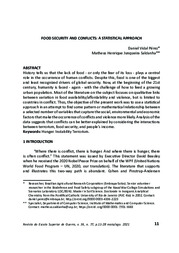Food security and conflicts: a statistical approach.
Food security and conflicts: a statistical approach.
Author(s): PEREZ, D. V.; SALDANHA, M. H. J.
Summary: History tells us that the lack of food - or only the fear of its loss - plays a central role in the occurrence of human conflicts. Despite this, food is one of the biggest and least recognized drivers of global security. Now, at the beginning of the 21st century, humanity is faced - again - with the challenge of how to feed a growing urban population. Most of the literature on the subject focuses on qualitative links between variation in food availability/affordability and violence, but is limited to countries in conflict. Thus, the objective of the present work was to use a statistical approach in an attempt to find some pattern or mathematical relationship between a selected number of variables that capture the social, environmental and economic factors that make the occurrence of conflicts and violence more likely. Analysis of the data suggests that conflicts can be better explained by considering the interactions between terrorism, food security, and people's income.
Publication year: 2021
Types of publication: Journal article
Unit: Embrapa Soils
Keywords: Fome, Food security, Hunger, Instabilidade, Instability, Segurança Alimentar, Terrorism, Terrorismo
Observation
Some of Embrapa's publications are published as ePub files. To read them, use or download one of the following free software options to your computer or mobile device. Android: Google Play Books; IOS: iBooks; Windows and Linux: Calibre.
Access other publications
Access the Agricultural Research Database (BDPA) to consult Embrapa's full library collection and records.
Visit Embrapa Bookstore to purchase books and other publications sold by Embrapa.

